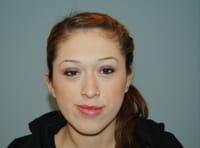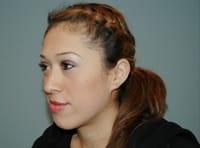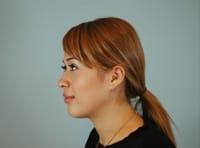Jaw Deformities Care Program
At the Jaw Deformities Care Program in the Division of Plastic and Maxillofacial Surgery , we take pride in providing today’s most advanced care for your child in a caring, family-focused environment.
Our multispecialty team includes leaders in the fields of nursing, psychology, genetics, orthodontics, oral/maxillofacial surgery and plastic and reconstructive surgery. We see patients from throughout Southern California and the United States, as well as from international locations.
Only an experienced oral, maxillofacial surgeon or orthodontist can determine if your child needs jaw surgery. The surgeon and the orthodontist work closely together to determine the right approach to help place the upper and lower jaws into better alignment. A general dentist is also part of the team and helps maximize your child's oral health before, during and after orthodontic and surgical treatment.
Commonly Treated Conditions
We treat a broad spectrum of patients with jaw deformities, including newborns with respiratory difficulties due to a small lower jaw, adolescents with obstructive sleep apnea and craniofacial deformities or growth disturbances of the jaws including:
- Congenital Facial Paralysis
- Moebius Syndrome
- Traumatic Facial Paralysis
Patients who can potentially benefit from jaw surgery, include those with:
- Cleft Lip and Palate
- Developmental Skeletal Dysplasia
- Hemifacial Microsomia
- Pierre Robin Sequence
- Treacher Collins Syndrome
To be a candidate for jaw surgery, your child may be a:
- Neonate with obstructive sleep apnea who requires distraction of the lower jaw.
- Child with an improper bite or improper jaw growth.
- Teen with a previous history of cleft lip or palate or craniofacial syndromes. We recommend evaluation for potential complex jaw surgery to correct any misalignment of bones.
- Teen who is otherwise healthy but who has a discrepancy in jaw size.
Jaw Surgery Appointments
The Initial Consultation
The initial surgical consultation provides the surgeon with an opportunity to obtain your child's medical history and examine your child. It will also allow you the opportunity to ask any questions that you may have. It is important for you to be well informed about your child’s treatment. This includes understanding the need and timing for pre-surgical orthodontics. We will then take the time to make sure you understand your child’s individualized orthognathic surgical plan.
The Second Consultation
During a second consultation, we will complete a thorough examination with facial measurements, digital photographs, x-rays, 3D analysis and dental impressions. Pre-surgical orthodontics may be employed to move your child’s teeth into a position that will facilitate a good fit after recovery. During this pre-surgical orthodontic phase of treatment, which usually lasts six to eight months, the patient will be wearing braces and will visit an orthodontist regularly for necessary adjustments and ongoing evaluation. If the patient still has his or her wisdom teeth or the teeth are too crowded, it may be necessary to remove certain teeth prior to beginning orthodontic treatment in order to make space for proper tooth movement.
Ready for Jaw Surgery
As the orthodontic phase nears completion, we will verify that your child’s overall skeletal growth has completed (usually 16-17 years of age for females and 17-20 years of age for males). At that point, he or she will be ready for jaw surgery. We will ask you to return for the pre-operative surgical workup to finalize a treatment plan for corrective jaw surgery. This complex analysis includes:
- Routine digital photographic analysis
- Radiographic analysis
- Dental study models
- Facial proportion and bite analysis
- Computerized treatment planning with three-dimensional (3D) analysis
- Simulation of the surgical movements on study models
- Splint fabrication
The information is collected and utilized to perform a “mock” surgery, where the surgeon performs the proposed operation on study models and on a 3D image to simulate the proposed movements.
Jaw Surgery Procedures
About the Surgical Procedures
Surgery is performed by at least two surgeons, following the steps that have been pre-planned on models and using mathematical algorithms. The length of the operation depends on the complexity of the case and how extensive the movement of the jaws needs to be.
Orthognathic surgical procedures last anywhere from two to six hours, depending on the amount and type of surgery needed. In lower jaw surgery, the rear portion of the jawbone behind the teeth is separated and the tooth-bearing portion is moved forward or backward, as appropriate. In upper jaw surgery, the jaw can be repositioned forward or backward, or the jaw can be raised or lowered.
Certain movements may require the jaws to be separated into several parts, with bone added or removed to achieve the proper alignment and stability. Other facial bones that contribute to the imbalance may also be repositioned, augmented or reduced in size.
Two Weeks Prior to Surgery
Most orthognathic surgery is performed in a hospital under general anesthesia. Prior to surgery, your child will have a physical examination to ensure he or she is in good overall health. This final pre-operative visit will allow us to try on the splint that was custom-fabricated for your child’s operation. We will review the operation with you one more time to make sure you understand the events that will happen on the day of surgery. Any required lab tests will also be done prior to surgery. After the extensive workup and simulation have been completed, the operation can proceed.
The Morning of Surgery
The morning of the operation, you will check into the hospital and complete your registration. You will be taken to the pre-operative check-in where a registered nurse will complete your child’s paperwork and exam. Then the anesthesiologist will discuss the general anesthetic procedure to be used and answer your questions.
Lefort I
In a Lefort I operation, the malocclusion is an open bite. In this case, the posterior portion of the upper jaw that has grown disproportionately has caused the open bite.
The Lefort I is done by making cuts in the upper jaw and removing the excess bone. This is done entirely from inside the mouth. The jaw is positioned in an anatomical position that will allow the lower jaw to rotate into a normal class 1 occlusion.
The upper jaw is secured with titanium plates. The plates are very thin and imperceptible.
Bilateral Sagittal Split Osteotomy (BSSO)
In a bilateral saggital split osteotomy (BSSO) surgery, cuts are made on the lower jaw, all from inside the mouth, to allow the lower jaw to slide forward into a normal bite.
As shown here, the malocclusion is a class 3, retrognathia. If the lower jaw is more prominent than the upper jaw, then the same operation can be used except the jaw bones will slide back backward into a normal occlusion. The BSSO operation sometimes requires making a very small two-millimeter incision on the skin of the face just below the ear. This small incision helps us place three screws into the jawbone on each side. The screws hold the bones in their new position. The screws are imperceptible.
Sometimes an orthognathic operation may require further augmentation of the chin. This can be accomplished with a sliding genioplasty. This allows the surgeon to make cuts on the chin portion of the lower jaw. All the cuts are made from inside the mouth and the chin portion is mobilized and positioned in a more harmonious position so the soft tissue can achieve proportionality. The chin point can be backward, forward, up or down. The chin is secured with small plates and screws that are virtually imperceptible.
After Jaw Surgery
In general, jaw surgery is very safe and the overall satisfaction rate of patients is very high. However, as with any surgical procedure, certain risks and complications are possible. The decision to recommend surgery is not taken lightly; you and your surgeon will consider the risks, benefits and options available based on your child’s individual treatment plan before you consent to surgery.
After your child’s surgery is completed, your child will be brought to our post-surgery recovery area. Your child’s surgical team will check to make sure that he or she is stable in recovery. After that, your child will be transferred to our specialized recovery unit. He or she will be encouraged to start taking in fluids and slowly advance to pureed food. On the second post-operative day, your child will be encouraged to get out of bed and walk. Once the food intake by mouth is adequate, intravenous fluids will be stopped. Your child should be ready to go home by the second or third day.
Post-operatively your child will experience temporary swelling of the lips and cheeks, as well as a mild temporary numbness at the point of surgery; this will improve when the swelling goes down.
Your child also may have mild sinus and nasal congestion, along with a sore throat for a few days. We will take all necessary steps to make sure the symptoms are controlled. You will be given a decongestant and nasal spray to help alleviate nasal symptoms, along with throat lozenges as needed.
The first three to four weeks are crucial for the jawbones to heal well. Limiting mobility at the surgical site is paramount to facilitate proper healing. Your child most likely will wear guiding elastics to help minimize bite forces and guide the bite to the new position. Some patients will require a period of complete immobilization of the jaws with elastic rubber bands.
Nutritional intake is important to help the healing process. The first three to four weeks will require a pureed diet. We will provide you a nutritional guide for your child. Most patients are able to return to school by the second postoperative week. However, we ask that your child avoid strenuous exercise and contact sports for four to six weeks.
Below is an overview of side effects that your child could experience during their recovery:
- Swelling
Post-operative swelling should be anticipated and will vary based on the extent of the operation. The post-operative swelling will peak around 72 hours after the operation. By day four, the swelling will start to dissipate. Improvement will continue until the swelling subsides, which may take three to four weeks. - Nausea
Some patients experience nausea as a side effect of general anesthesia. We take measures to help minimize nausea including administering intravenous (IV) medications that help decrease nausea pre-operatively, intra-operatively and post-operatively. Feelings of nausea usually subside by the second day after surgery. - Discomfort
The discomfort following orthognathic surgery is usually mild and is mostly attributed to swelling. We take preemptive steps to make sure that your child is comfortable after surgery with pain management medications. - Minor Bleeding
Since most of the surgery is done from inside the mouth, there will be some mild oozing of blood from the mouth or nose. We will take steps to minimize this effect by having your child sleep with the head of the bed elevated at 45 degrees for the first three-to-four days. We will give him or her nasal sprays to help keep the nasal cavities open. In the rare event that your child experiences excessive or prolonged bleeding after you return home, contact your surgeon immediately. - Loss or Alteration of Nerve Sensation
Your child may experience a temporary alteration in sensation of the face, jaw, teeth or tongue. This occurs due to post-operative swelling and stretching of the nerves that may occur with movement of the jaws. As the swelling goes away and the healing process continues, most sensation will return. Most individuals have functional sensory return by six months postoperatively and have no complaints. However, some individuals may experience permanent altered sensations, particularly in lower jaw operations if a nerve is cut or excessively stretched. If a nerve is cut during your child's operation, we will repair it to try to maximize potential return of sensation. - Infection
Post-operative infection is a possibility with any operation. We take steps to minimize that risk, including giving your child intravenous (IV) antibiotics before surgery. Also, most patients are kept on antibiotics for four-to-five days after surgery to help minimize the risk of infection to the plates and screws used. In the rare event that a plate or screw becomes infected, it may need to be removed. - Sinus Complications
The LeFort operation requires manipulation of the maxillary sinus membrane. Sinus discomfort or congestion may occur after surgery. If needed, we will provide a decongestant. Most sinus symptoms subside within one week. We will ask that your child not fly during the first seven days after surgery. - Injuries to Adjacent Teeth
All precautions are taken to avoid injury to teeth during orthognathic surgery. In the unlikely event that teeth are injured, then we will refer your child to our restorative dental team for care. - Relapse
Patients with a history of clefts are more prone to relapse. More complex operations have a higher risk of relapse. Because of our extensive history of treating complex craniofacial cases, we have developed an algorithm to help minimize relapse after surgery. This may require that a splint be placed on the teeth for six weeks to help maximize the opportunity to keep your child’s bite in an acceptable position. In a small subset of patients, further surgical treatment may be necessary. - Temporomandibular Joint Pain
After surgery, there may be inflammation and swelling in the jaw joints. This usually subsides by the first week. We will give your child an anti-inflammatory medication to help minimize these effects. Persistent abnormal function in the jaw joint has been reported; however, it is rare.
Follow-up Appointments
Your child will have a follow-up appointment with your surgeon two weeks after surgery to make sure that he or she is healing well. In addition, your child will need to continue seeing an orthodontist. Most orthodontists will remove the braces six to eight months after surgery. Your will continue to see your surgeon regularly for the first year to make sure that he or she achieves an optimal result.
Before and After Photos
We highly recommend you ask your othognathic surgeon to show you pre- and post-surgery pictures of patients he or she personally has operated on. The surgeon should be able to show you a variety of pictures of maxillary and mandibular osteotomies (LeFort and BSSO).
Example #1
The 18-year-old male below had undergone right ear reconstruction and wanted a more prominent lower jaw. His bite was normal. We performed chin surgery (a genioplasty) to help him achieve good facial balance.
Before Surgery
After Surgery
Weak chin/lower jawImproved chin projection
Example #2
The 18-year-old female below came to us with hemifacial microsomia and vertical maxillary excess (VME). Her face and jaws grew with a crooked cant with her upper jaw being prominent, she had a “gummy” smile and her chin is deviated to the left.
Before Surgery
After Surgery
Example #3
The 18-year-old male below came to us with developmental skeletal dysplasia. His upper/lower jaws were too small with poor projection. For his malocclusion, he underwent several orthognathic procedures, including a LeFort, a BSSO and a genioplasty for correction of his bite and to achieve better facial balance.
Before Surgery
After Surgery
Example #4
The 18-year old male below presented with developmental skeletal dysplasia. His upper jaw was too small with poor projection and his bite was off. We performed a LeFort procedure and advanced the upper jaw forward to correct the bite and achieve a more proportionate facial balance.
Before Surgery
After Surgery
Example #5
Before Surgery

After Surgery





